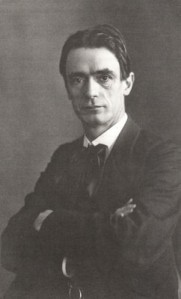Biodynamics and Nazi Market Gardens November 15, 2010
Author: Beach Combing | in : Contemporary , trackback Biodynamics is a form of agriculture that Beachcombing can best describe as ‘organic and then some’. It demands that the farmer treat his or her farm as a single organism and that said farmer use ‘natural’ methods to raise crops and cattle. This includes supplements for fields that are, to say the least, unusual – e.g. quartz solution kept in a cow’s horn, sprayed at astrologically determined intervals. It also includes unusual pest controls: so field mice are driven away with incinerated field mice, burnt when Venus lies in Scorpio.
Biodynamics is a form of agriculture that Beachcombing can best describe as ‘organic and then some’. It demands that the farmer treat his or her farm as a single organism and that said farmer use ‘natural’ methods to raise crops and cattle. This includes supplements for fields that are, to say the least, unusual – e.g. quartz solution kept in a cow’s horn, sprayed at astrologically determined intervals. It also includes unusual pest controls: so field mice are driven away with incinerated field mice, burnt when Venus lies in Scorpio.
Much of this came from the perspiring mind of Rudolf Steiner (pictured here) who came up with biodynamics in a series of lectures in Silesia in 1924.
The time and place of Steiner’s lecture was both the fortune and misfortune of the movement because it quickly brought maturing biodynamics into a political system that was as irrational as itself, but that lacked the bios’ tender loving care and cosmic vibes. Indeed, Nazism first tried to throttle biodynamics – from 1933 – then, subsequently, suffocated it with kisses.
Beachcombing will get the less interesting ‘kill’ phase out of the way as quickly as possible. Rudolf Steiner’s racial ideas were not extreme enough for the Nazi party: Steiner had the honour of being verbally attacked by Hitler. So in 1935 Steiner’s Anthroposophical Society was banned – part of that strange Nazi persecution of strange groups that would lead, inter alia, to the martyrdom of over two thousand Jehovah’s Witnesses. And government nutrition bodies were set, like so many dogs, on biodynamic farmers.
At this point though the bios fought back and they did so using techniques the regime would understand. They claimed that the achievements of biodynamic farms spoke for themselves: and Beachcombing must admit some of these achievements were impressive – placebo effect for legumes…?
But more importantly they plugged into the susceptibility/sympathy of some high up Nazis for the occult, stating that they themselves were also pioneers of Blood and Soil – the Nazis belief in the connection between race and locale.
Here the twitchy antennae of the senior party members, particularly ‘the Green-wing of the Nazi party’, started to flick up and down. Rudolf Hess – deputy führer and an individual who would later prove his grasp of reality by parachuting into Scotland to single-handedly end the war – took up the cudgel for what was essentially ‘homeopathic’ farming.
In 1935 Wilhelm Frick the German Home Minister was converted and in the late 1930s, crucially, Walther Darré, the Minister of Agriculture began to support biodynamic farming. And though the movement never entirely came in from the cold – a new round of persecution began in 1941 – it was taken more seriously by the Nazi government than any other ‘green’ farming movement has been taken by modern governments. (Beachcombing is waiting to be contradicted…).
Auschwitz, Ravensbrück and Dachau would have biodynamic gardens in their grounds… These gardens were run by inmates and continued to be planted until 1945. Beachcombing will mention as an aside that Himmler also ran alchemists out of Dachau – another day, another post.
It was in this period of uneasy cohabitation that the biodynamic movement got its hand dirty with things other than quartz fertiliser. If concentration camp market gardens – imagine taking that stuff to farmer’s market! – are not enough then Max Schwarz claimed in his Ein Weg zum praktischen Siedeln (back in 1933) that biodynamic farms would help ‘cure’ the land by settling ethnic Germans on ‘virgin’ German territory out in ‘uninhabited’ Eastern Europe (Treitel 149-).
Lebensraum…
Much modern scholarship has played down the ‘alternative’ elements in Nazism – alchemy and the like, not least because of a post-war French obsession in playing them up. Here , however, is a nice example of the party being open to schemes of thinking that no government in, say, the 1930s US, UK or Italy would have touched with a barge pole.
Does this make biodynamics inherently ‘Nazi’?
Of course not.
Beachcombing is not a big fan of Steiner: a cut price Goethe without the angst or hair. There is also a rather scary lady at Little Miss B’s nursery who is forever going on about Blavatsky’s most successful student – but that is another story.
However, if organisations and movements could be permanently dishonoured by association with Hitler’s crooked cross then there are also many churches (too, too many…), vegetarians, Indian and Irish nationalists, proponents of free love and several of Germany’s democratic neighbours who should now be permanently shunned.
Certainly, biodynamics overlapped with Nazism – something that could be said of socialism, capitalism and almost every other conceivable political and economic system. This points not to universal evil – though Beachcombing would be happy to make a case for that too – but to the Nazi party’s impressive ability to be everything to everyone.
In the case of biodynamics the overlap took place on a visceral and fundamental corner of both thinking systems – a rewriting of the sacred compact between man and the land, lost in the process of industrialisation – or so the sages tell us.
Beachcombing is always interested in the queerer sides of Nazi thinking: Drbeachcombing AT yahoo DOT com


